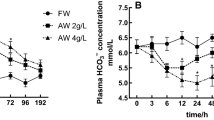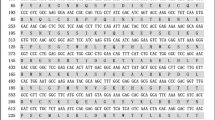Abstract
1. Carbonic anhydrase in the gills of the freshwater teleost,Etroplus maculatus, was demonstrated to be influenced by transfer of the animal to saline media.
2. Sudden and direct exposure of the fish to saline media resulted in a decrease of the enzyme activity.
3. The enzyme activity was reduced gradually with progressive increase of the salinity after two months acclimation of the fish in the medium.
4. It was concluded that reduced carbonic anhydrase activity of the gill on acclimation to higher salinities, is associated with Cl− uptake but not Cl− excretion.
Similar content being viewed by others
References
Flemister, S. C... “Histophysiology of gill and kidney of crab,Ocypode albicans,”Biol. Bull., 1959,116, 37–48.
Garcia Romeu, F. and Maetz, J. “The mechanism of sodium and chloride uptake by the gills of a freshwater fish,Carassius auratus. I. Evidence for an independent uptake of sodium and chloride ions,”J. gen. Physiol., 1964,47, 1195–1207.
Grainger, J. N. R... “The initial metabolic responses to temperature change in poikilotherms,” inPhysiological Adaptation (Ed., C. L. Prosser), Washington, American Physiological Society, 1958, pp. 79–90.
Jozuka, K... “Chloride regulation by the gill of the freshwater teleost,Carassins auratus,”Annot. Zoo. Japon, 1967,40, 205–10.
Krogh, A...Osmotic Regulation in Aqatic Animals, Cambridge University Press, London, 1939.
Maetz, J. .. As quoted by Maetz and Romeu (1964), 1953.
Maetz, J... “Les echanges de sodium chez le poissonCarrasius auratus. Action d’um inhibite ur de L’anhydrase carbonique,”J. Physiol. Paris, 1956,48, 1085–99.
—— and Garcia Romeu, F. “The mechanism of sodium and chloride uptake by the gills of a freshwater fishCarassins auratus. II. Evidence for NH +4 /Na+ and HCO −3 /Cl− exchanges,”J. gen. Physiol., 1964,47, 1209–27.
Maren, T. H... “Carbonic anyhydrase: Chemistry, physiology and inhibition,”Physiol. Revs., 1967,47, 595–781.
Pampapathi Rao, K... “Salinity tolerance ofEtroplus maculatus (Bloch.),”Curr. Sci., 1958,27, 99.
Parvatheswara Rao, V... “Influence of different temperature-salinity combinations on the oxygen consumption in the freshwater fishEtroplus maculatus (Teleostei),”Helgol. wiss. Meerasunters, 1965,12, 301–14.
Roughton, F. J. W. and Booth, V. H. “The effect of substrate concentration, pH and other factors upon the activity of carbonic anhydrase,”Biochem. J., 1946,40, 319–30.
Van Goor, H... “Carbonic anhydrase, its properties, distribution and significance for carbon dioxide transport,”Enzymologia, 1948,13, 73–164.
Virabhadrachari, V... “Structural changes in the gills, intestine and kidney ofEtroplus maculatus (Teleostei) adapted to different salinities,”Quart. J. Micr. Sci., 1961,102, 361–69.
Waygood, E. R... InMethods in Enzymology (Edrs. S. P. Colowick and N. O. Kaplan), Academic Press, Inc., New York, 1955,2, 839.
Author information
Authors and Affiliations
Additional information
Communicated by Prof. S. Krishnaswamy,f.a.sc.
Rights and permissions
About this article
Cite this article
Krishnamoorthy, R.V., Virabhadrachari, V. Carbonic anhydrase activity in the gills ofEtroplus maculatus (Teleostei) as a function of salinity acclimation. Proc. Indian Acad. Sci. 69, 235–240 (1969). https://doi.org/10.1007/BF03052538
Received:
Issue Date:
DOI: https://doi.org/10.1007/BF03052538




